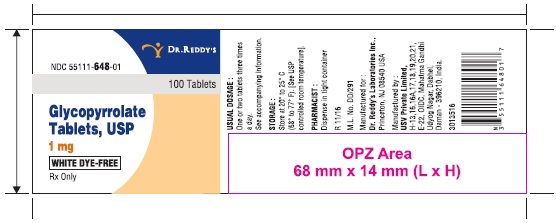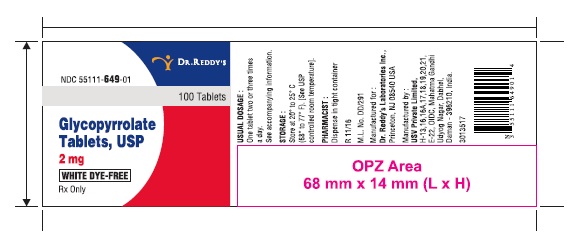Glycopyrrolate by Dr. Reddy's Laboratories Limited / USV Limited GLYCOPYRROLATE tablet
Glycopyrrolate by
Drug Labeling and Warnings
Glycopyrrolate by is a Prescription medication manufactured, distributed, or labeled by Dr. Reddy's Laboratories Limited, USV Limited. Drug facts, warnings, and ingredients follow.
Drug Details [pdf]
-
DESCRIPTION
Glycopyrrolate tablets, USP contain the synthetic anticholinergic,glycopyrrolate. Glycopyrrolate is a quaternary ammonium compound withthe following chemical name: 3-[(cyclopentylhydroxyphenylacetyl)oxy]-1,1-dimethylpyrrolidinium bromide.
The structural formula of Glycopyrrolate is represented below:

Molecular Formula : C19H28BrNO3 Molecular Weight :398.33
Each tablet for oral administration contains 1 mg or 2 mg Glycopyrrolate, USP.
Inactive Ingredients: Dibasic Calcium Phosphate, Lactose Monohydrate, Magnesium Stearate, Povidone and Sodium Starch Glycolate.
-
CLINICAL PHARMACOLOGY
Glycopyrrolate, like other anticholinergic (antimuscarinic) agents, inhibits the action of acetylcholine on structures innervated by postganglionic cholinergic nerves and on smooth muscles that respond to acetylcholine but lack cholinergic innervation. These peripheral cholinergic receptors arepresent in the autonomic effector cells of smooth muscle, cardiac muscle,the sino-atrial node, the atrioventricular node, exocrine glands, and, to alimited degree, in the autonomic ganglia. Thus, it diminishes the volume and free acidity of gastric secretions and controls excessive pharyngeal,tracheal, and bronchial secretions.
Glycopyrrolate antagonizes muscarinic symptoms (e.g., bronchorrhea, bronchospasm, bradycardia, and intestinal hypermotility) induced bycholinergic drugs such as the anticholinesterases.
The highly polar quaternary ammonium group of glycopyrrolate limits its passage across lipid membranes, such as the blood-brain barrier, in contrastto atropine sulfate and scopolamine hydrobromide, which are non-polartertiary amines which penetrate lipid barriers easily.
- INDICATIONS AND USAGE
-
CONTRAINDICATIONS
Glaucoma; obstructive uropathy (for example, bladder neck obstruction due to prostatic hypertrophy); obstructive disease of the gastrointestinal tract (as in achalasia, pyloroduodenal stenosis, etc.); paralytic ileus; intestinal atony of the elderly or debilitated patient; unstable cardiovascularstatus in acute hemorrhage; severe ulcerative colitis; toxic megacolon complicating ulcerative colitis; myasthenia gravis. Glycopyrrolate tablets are contraindicated in those patients with a hypersensitivity to glycopyrrolate.
-
WARNINGS
In the presence of a high environmental temperature, heat prostration (fever and heat stroke due to decreased sweating) can occur with use of Glycopyrrolate tablets.
Diarrhea may be an early symptom of incomplete intestinal obstruction, especially in patients with ileostomy or colostomy. In this instance treatment with this drug would be inappropriate and possibly harmful.
Glycopyrrolate tablets may produce drowsiness or blurred vision. In this event, the patient should be warned not to engage in activities requiring mental alertness such as operating a motor vehicle or other machinery, or performing hazardous work while taking this drug.
Theoretically, with overdosage, a curare-like action may occur, i.e., neuro-muscular blockade leading to muscular weakness and possible paralysis.
Pregnancy
The safety of this drug during pregnancy has not been established. The use of any drug during pregnancy requires that the potential benefits of the drug be weighed against possible hazards to mother and child. Reproduction studies in rats revealed no teratogenic effects from glycopyrrolate; however, the potent anticholinergic action of this agent resulted in diminished rates of conception and of survival at weaning, in a dose-related manner. Other studies in dogs suggest that this may be due to diminished seminal secretion which is evident at high doses of glycopyrrolate. Information on possible adverse effects in the pregnant female is limited to uncontrolled data derived from marketing experience. Such experience has revealed no reports of teratogenic or other fetus-damaging potential. No controlled studies to establish the safety of the drug in pregnancy have been performed.
-
PRECAUTIONS
Use Glycopyrrolate tablets with caution in the elderly and in all patients with:
- Autonomic neuropathy.
- Hepatic or renal disease.
- Ulcerative colitis-large doses may suppress intestinal motility to the point of producing a paralytic ileus and for this reason may precipitate or aggravate "toxic megacolon," a serious complication of the disease.
- Hyperthyroidism, coronary heart disease, congestive heart failure, cardiac tachyarrhythmias, tachycardia, hypertension and prostatic hypertrophy.
- Hiatal hernia associated with reflux esophagitis, since anticholinergic drugs may aggravate this condition.
-
ADVERSE REACTIONS
Anticholinergics produce certain effects, most of which are extensions of their fundamental pharmacological actions. Adverse reactions to anticholinergics in general may include xerostomia; decreased sweating; urinary hesitancy and retention; blurred vision; tachycardia; palpitations; dilatation of the pupil; cycloplegia; increased ocular tension; loss of taste; headaches; nervousness; mental confusion; drowsiness; weakness; dizziness; insomnia; nausea; vomiting; constipation; bloated feeling; impotence; suppression of lactation; severe allergic reaction or drug idiosyncrasies including anaphylaxis, urticaria and other dermal manifestations.
Glycopyrrolate tablets is chemically a quaternary ammonium compound; hence, its passage across lipid membranes, such as the blood-brain barrier, is limited in contrast to atropine sulfate and scopolamine hydrobromide. For this reason the occurrence of CNS related side effects is lower, in comparison to their incidence following administration of anticholinergics which are chemically tertiary amines that can cross this barrier readily.
-
OVERDOSAGE
The symptoms of overdosage of glycopyrrolate are peripheral in nature rather than central.
- 1. To guard against further absorption of the drug-use gastric lavage, cathartics and/or enemas.
- 2. To combat peripheral anticholinergic effects (residual mydriasis, dry mouth, etc.)-utilize a quaternary ammonium anticholinesterase, such as neostigmine methylsulfate.
- 3. To combat hypotension-use pressor amines (norepinephrine, metaraminol) i.v.; and supportive care.
- 4. To combat respiratory depression-administer oxygen; utilize a respiratory stimulant such as Dopram® i.v.; artificial respiration.
-
DOSAGE AND ADMINISTRATION
The dosage of Glycopyrrolate tablets 1 and 2 mg should be adjusted to the needs of the individual patient to assure symptomatic control with a minimum of adverse reactions. The presently recommended maximum daily dosage of Glycopyrrolate is 8 mg.
Glycopyrrolate, 1 mg Tablets. The recommended initial dosage of Glycopyrrolate for adults is one tablet three times daily (in the morning, early afternoon, and at bedtime). Some patients may require two tablets at bedtime to assure overnight control of symptoms. For maintenance, a dosage of one tablet twice a day is frequently adequate.
Glycopyrrolate, 2 mg Tablets. The recommended dosage of Glycopyrrolate for adults is one tablet two or three times daily at equally spaced intervals.
Glycopyrrolate tablets are not recommended for use in pediatric patients under the age of 12 years.
- DRUG INTERACTIONS
-
HOW SUPPLIED
Glycopyrrolate Tablets USP, 1 mg are scored, compressed white tabletsengraved ‘I 21’, and are supplied in bottles of 100’s and 500’s.
Bottles of 100 NDC: 55111-648-01
Bottles of 500 NDC: 55111-648-05.
Glycopyrrolate Tablets USP, 2 mg are scored, compressed white tabletsengraved ‘I 22’, and are supplied in bottles of 100’s and 500’s.
Bottles of 100 NDC: 55111-649-01
Bottles of 500 NDC: 55111-649-05.
Store at 20° to 25°C (68° to 77°F). [See USP controlled room temperature].
Dispense in tight container.
Manufactured for:
Dr. Reddy’s Laboratories Inc.,
Princeton, NJ 08540 USA
Manufactured by:
USV Private Limited,
H-13,16,16A,17,18,19,20,21,E-22, OIDC,
Mahatma Gandhi Udyog Nagar,
Dabhel, Daman 396 210, India
Revised: 1116
- PACKAGE LABEL PRINCIPAL DISPLAY PANEL SECTION
- PRINCIPAL DISPLAY PANEL
-
INGREDIENTS AND APPEARANCE
GLYCOPYRROLATE
glycopyrrolate tabletProduct Information Product Type HUMAN PRESCRIPTION DRUG Item Code (Source) NDC: 55111-648 Route of Administration ORAL Active Ingredient/Active Moiety Ingredient Name Basis of Strength Strength Glycopyrrolate (UNII: V92SO9WP2I) (Glycopyrronium - UNII:A14FB57V1D) Glycopyrrolate 1 mg Inactive Ingredients Ingredient Name Strength Lactose monohydrate (UNII: EWQ57Q8I5X) Magnesium stearate (UNII: 70097M6I30) Povidone (UNII: FZ989GH94E) SODIUM STARCH GLYCOLATE TYPE A POTATO (UNII: 5856J3G2A2) ANHYDROUS DIBASIC CALCIUM PHOSPHATE (UNII: L11K75P92J) Product Characteristics Color WHITE Score 2 pieces Shape ROUND Size 10mm Flavor Imprint Code I;21 Contains Packaging # Item Code Package Description Marketing Start Date Marketing End Date 1 NDC: 55111-648-01 100 in 1 BOTTLE; Type 0: Not a Combination Product 07/14/2008 2 NDC: 55111-648-05 500 in 1 BOTTLE; Type 0: Not a Combination Product 07/14/2008 Marketing Information Marketing Category Application Number or Monograph Citation Marketing Start Date Marketing End Date ANDA ANDA040847 07/14/2008 GLYCOPYRROLATE
glycopyrrolate tabletProduct Information Product Type HUMAN PRESCRIPTION DRUG Item Code (Source) NDC: 55111-649 Route of Administration ORAL Active Ingredient/Active Moiety Ingredient Name Basis of Strength Strength Glycopyrrolate (UNII: V92SO9WP2I) (Glycopyrronium - UNII:A14FB57V1D) Glycopyrrolate 1 mg Inactive Ingredients Ingredient Name Strength Lactose monohydrate (UNII: EWQ57Q8I5X) Magnesium stearate (UNII: 70097M6I30) Povidone (UNII: FZ989GH94E) ANHYDROUS DIBASIC CALCIUM PHOSPHATE (UNII: L11K75P92J) SODIUM STARCH GLYCOLATE TYPE A POTATO (UNII: 5856J3G2A2) Product Characteristics Color WHITE Score 2 pieces Shape ROUND Size 13mm Flavor Imprint Code I;22 Contains Packaging # Item Code Package Description Marketing Start Date Marketing End Date 1 NDC: 55111-649-01 100 in 1 BOTTLE; Type 0: Not a Combination Product 07/14/2008 2 NDC: 55111-649-05 500 in 1 BOTTLE; Type 0: Not a Combination Product 07/14/2008 Marketing Information Marketing Category Application Number or Monograph Citation Marketing Start Date Marketing End Date ANDA ANDA040847 07/14/2008 Labeler - Dr. Reddy's Laboratories Limited (650562841) Establishment Name Address ID/FEI Business Operations USV Limited 650434348 analysis(55111-648, 55111-649) , manufacture(55111-648, 55111-649)
© 2025 FDA.report
This site is not affiliated with or endorsed by the FDA.

